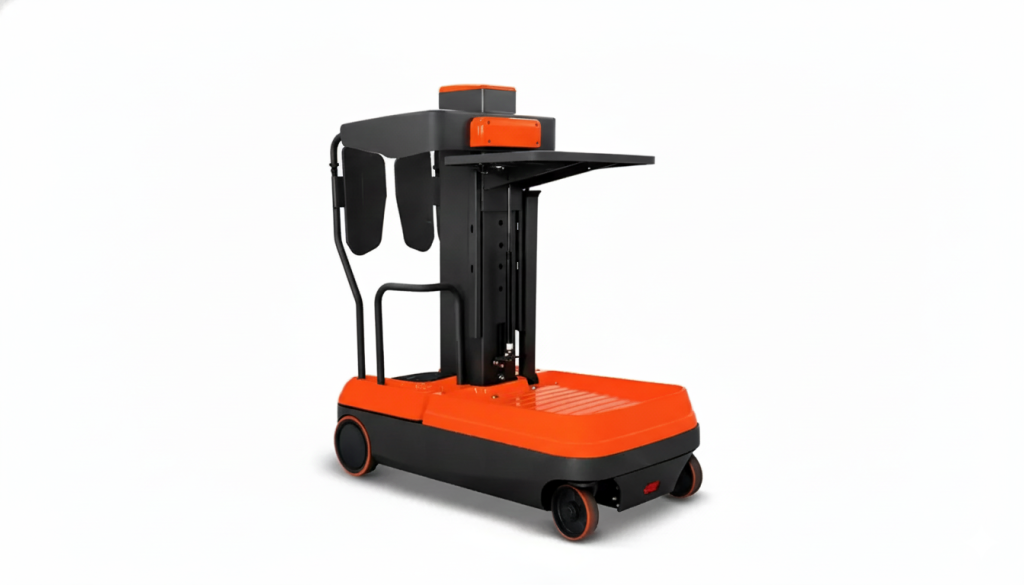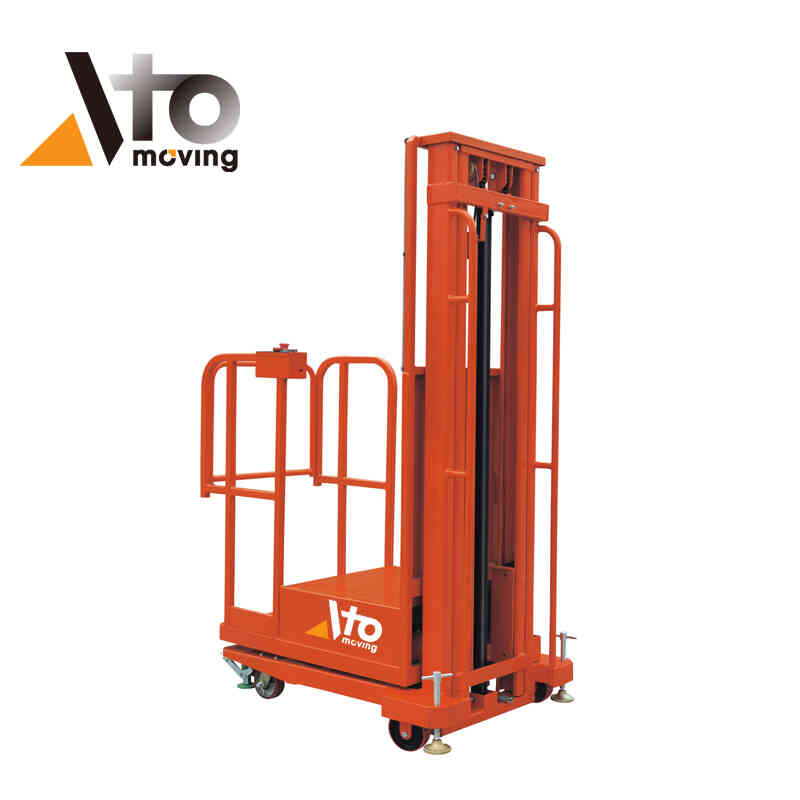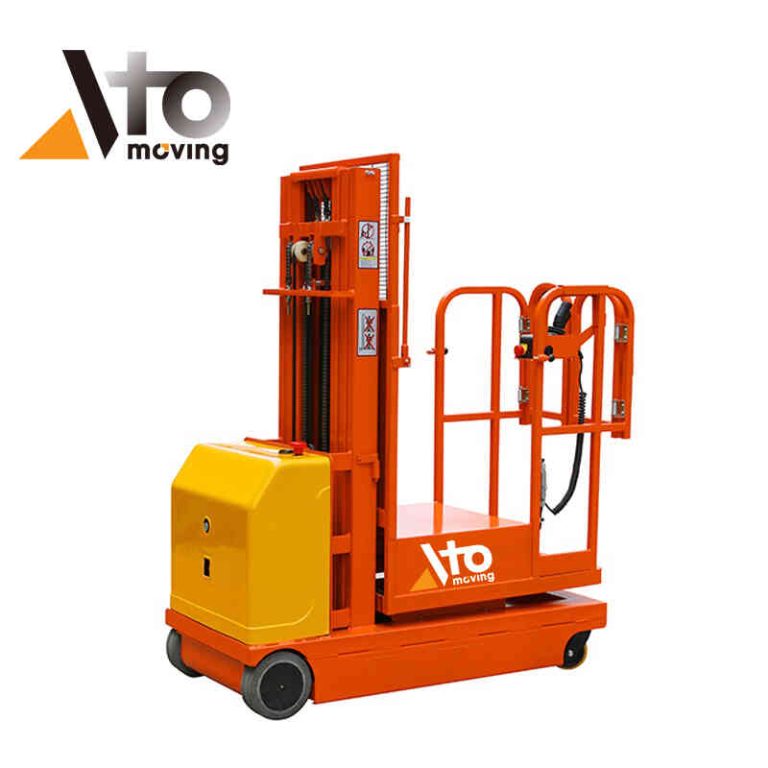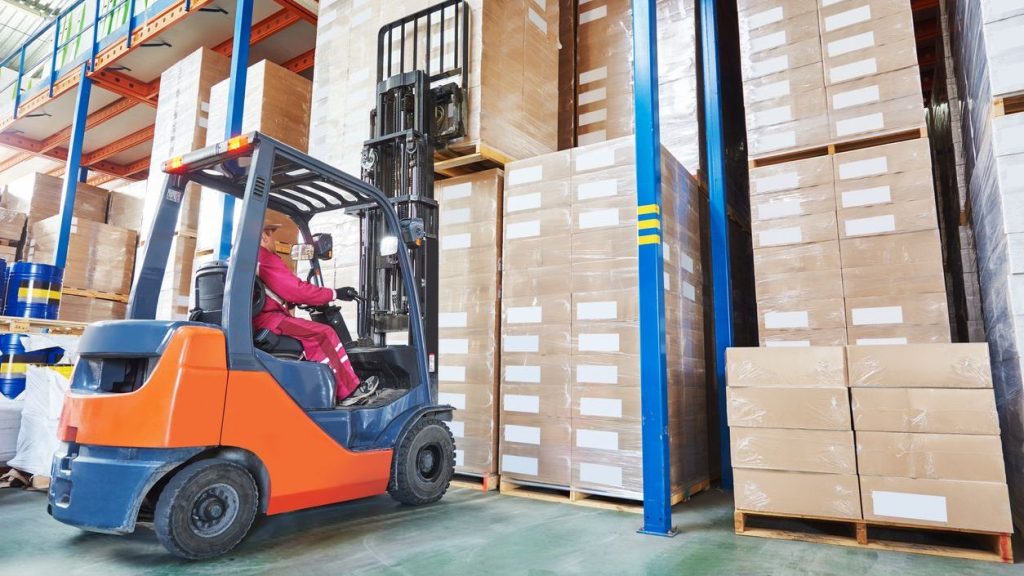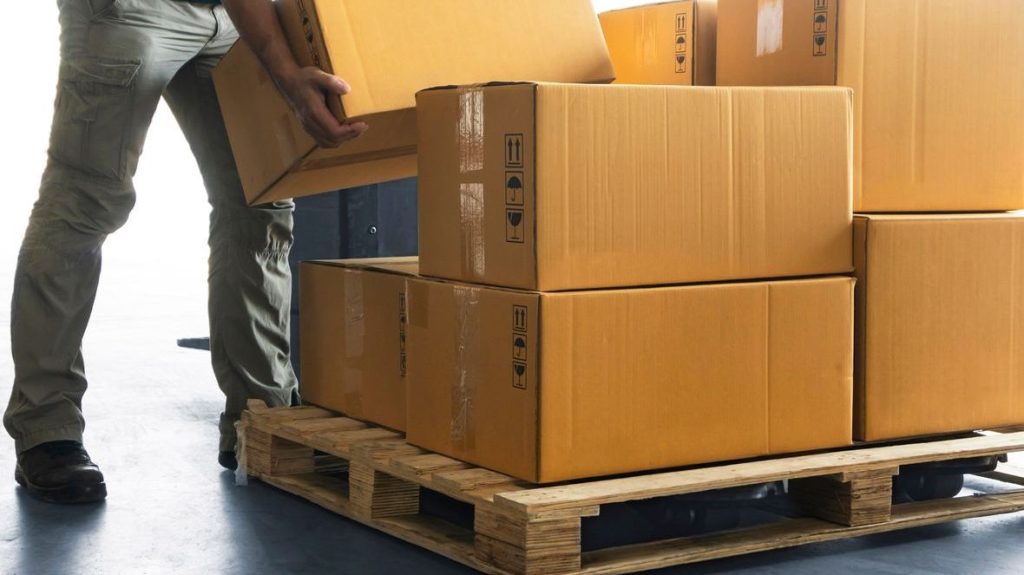Selecting the right material handling equipment can dramatically impact your warehouse’s efficiency, safety record, and bottom line. Two of the most common pieces of equipment—forklifts and order pickers—serve distinct purposes in modern logistics operations, yet confusion about their optimal applications persists among warehouse managers.
While forklifts excel at moving heavy pallets across horizontal distances, order pickers are specifically designed for vertical retrieval of individual items or cases from high-bay storage. Understanding the fundamental differences between a forklift vs an order picker is essential for making informed equipment investments that align with your operational requirements.
This comprehensive guide examines both machines across multiple dimensions to help you determine which solution best serves your warehouse needs.
Table of Contents
- Understanding Forklifts: Design and Primary Functions
- Order Pickers Explained: Purpose-Built for Vertical Selection
- Key Differences Between Forklifts and Order Pickers
- Operational Applications: When to Use Each Equipment Type
- Cost Comparison: Investment and Operating Expenses
- Safety Considerations for Both Equipment Types
- Making the Right Choice for Your Warehouse
- Conclusion
- Frequently Asked Questions
Understanding Forklifts: Design and Primary Functions
Forklifts represent the backbone of material handling operations worldwide, with over one million units currently in use across North American warehouses alone. These versatile machines feature a counterbalance design, with the operator seated at the rear and hydraulic forks extending from the front to lift and transport palletized loads.
Core Forklift Capabilities
The primary function of a forklift centers on horizontal transportation of heavy loads across warehouse floors, loading docks, and outdoor yards. Standard sit-down forklifts can lift loads ranging from 3,000 to 15,000 pounds, with specialized models handling even greater capacities.
Key specifications:
- Typical lift height: 15 to 20 feet
- High-reach models: Up to 36 feet
- Load capacity: 3,000 to 15,000+ pounds
- Travel speed: 10 to 12 mph
Modern forklifts utilize electric, propane, or diesel power sources, each offering distinct advantages. Electric forklifts dominate indoor operations due to zero emissions and lower noise levels, while internal combustion models provide extended runtime and faster refueling for demanding outdoor applications or multi-shift operations.
Forklift Design Variations
The forklift family encompasses numerous specialized variants designed for specific applications:
Reach Trucks – Extend forks forward to access deeper racking while maintaining narrow aisle widths
Pallet Jacks – Manual or powered alternatives for ground-level pallet movement across short distances
Rough Terrain Forklifts – Enhanced suspension and large pneumatic tires for outdoor construction and lumber yard operations
Counterbalance Forklifts – Standard warehouse models for general-purpose pallet handling
Each forklift type shares a common operational philosophy: moving complete pallet loads efficiently from point A to point B, whether loading trucks, restocking production lines, or organizing bulk storage areas.
Order Pickers Explained: Purpose-Built for Vertical Selection
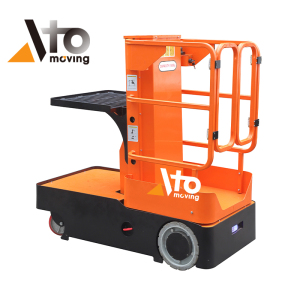
Order pickers represent a fundamentally different approach to warehouse operations, designed specifically for piece-picking and case-picking from elevated storage locations. Unlike forklifts that manipulate entire pallets, order pickers elevate the operator alongside a small platform to manually select individual items from racking systems.
How Order Pickers Function
The defining characteristic of an order picker is its elevating operator platform, which raises the worker to the precise height needed to access products stored on shelving or pallet racks. This design allows operators to pick individual items, partial cases, or specific quantities directly into totes or cartons on the platform, which then descend to ground level for processing.
Performance specifications:
- Standard reach heights: 20 to 30 feet
- Maximum heights: Beyond 35 feet for high-density facilities
- Load capacity: 500 to 2,500 pounds (operator + platform + picks)
- Travel speed: 4 to 6 mph (safety-focused)
The platform includes controls that allow operators to drive the machine horizontally along aisles while elevated, eliminating the need for repeated raising and lowering between pick locations.
Order Picker Categories
Low-Level Order Pickers
These units elevate operators up to 12 feet and excel in facilities with standard shelving heights and moderate pick volumes. These machines offer excellent maneuverability in tight spaces and represent the most economical entry point for vertical picking operations.
Medium-Level Order Pickers
Handling heights between 12 and 20 feet, medium-level order pickers balance reach capabilities with operational speed. These models dominate e-commerce fulfillment centers and retail distribution facilities where pick density and accuracy drive profitability.
High-Level Order Pickers
Extending beyond 20 feet, high-level order pickers serve high-bay warehouses maximizing cubic storage capacity. These sophisticated machines often incorporate advanced features like multi-level picking, automated positioning systems, and integrated weight scales to optimize high-volume order fulfillment.
Key Differences Between Forklifts and Order Pickers
Understanding the forklift vs order picker debate requires examining the fundamental operational distinctions between these equipment types across multiple dimensions.
Load Handling Philosophy
| Aspect | Forklifts | Order Pickers |
|---|---|---|
| Primary Function | Move complete pallet loads | Select individual items/cases |
| Operator Position | Remains at ground level | Elevates with platform |
| Load Capacity | 3,000 to 15,000+ lbs | 500 to 2,500 lbs |
| Handling Unit | Full pallets | Individual pieces/cases |
Forklifts manipulate complete pallet loads or other unitized cargo, moving hundreds or thousands of pounds in a single operation. The operator remains at ground level while the forks elevate to insert beneath pallets or engage specialized attachments. This design maximizes weight capacity and horizontal transport speed.
Order pickers prioritize access over capacity, elevating the operator to manually select individual items. Load capacities for order pickers typically range from 500 to 2,500 pounds—sufficient for the operator, platform, and accumulated picks, but far below forklift capabilities.
Operational Speed and Efficiency Metrics
Forklifts excel at rapid pallet movement, with experienced operators completing 20 to 30 pallet transfers per hour in optimal conditions. Travel speeds reach 10 to 12 miles per hour for counterbalance models, enabling quick movement across large warehouse footprints.
Order pickers optimize picks per hour rather than pallets moved. High-performing operations achieve 100 to 150 picks per hour with order pickers, depending on rack configuration, item density, and order complexity. Horizontal travel speeds remain modest—typically 4 to 6 miles per hour—as accuracy and safety take precedence over raw speed.
Warehouse Infrastructure Requirements
Forklift Requirements:
- Aisle width: 11 to 13 feet for counterbalance models
- Floor loading: Heavy-duty load-rated concrete
- Two-way traffic pattern accommodation
- Wide turning radius clearance
Order Picker Requirements:
- Aisle width: 5 to 7 feet for narrow aisle optimization
- Vertical clearance: 3 to 5 feet above maximum lift height
- High-density racking compatibility
- Precise positioning tolerance within inches of racking
Forklifts demand wider aisles to accommodate their turning radius, typically requiring 11 to 13 feet for counterbalance models. This wider aisle requirement reduces available storage density but facilitates rapid pallet flow and two-way traffic patterns.
Order pickers operate effectively in narrow aisles as tight as 5 to 7 feet, maximizing storage density in constrained facilities. The vertical orientation and precise controls allow operators to work within inches of racking uprights, extracting maximum value from available cubic space.
Operator Training and Certification
Both equipment types require OSHA-compliant operator training, but the skill development timelines differ significantly. Competent forklift operators typically emerge after 20 to 40 hours of combined classroom and practical training, with proficiency developing over several months of supervised operation.
Order picker certification follows similar formal requirements, but developing efficient picking techniques—including proper item identification, quantity verification, and ergonomic movement patterns—often requires extended on-the-job training periods of six months or more to achieve optimal productivity levels.
Operational Applications: When to Use Each Equipment Type
Matching equipment capabilities to operational requirements represents the most critical decision factor in the forklift vs order picker comparison.
Ideal Forklift Applications
Receiving Operations
Forklifts dominate operations centered on full pallet handling. Receiving departments rely on forklifts to unload trucks, verify incoming shipments, and transport pallets to putaway locations. Cross-docking operations that transfer pallets directly from inbound to outbound trailers operate most efficiently with forklift-based workflows.
Manufacturing Facilities
Manufacturing operations use forklifts to deliver raw materials to production lines and remove finished goods to staging areas. The ability to transport heavy loads across outdoor areas makes forklifts indispensable for lumber yards, building material suppliers, and any operation requiring all-weather material movement.
Bulk Storage Warehouses
Facilities that ship full pallets to retail stores or distribution centers structure their entire operation around forklift efficiency. These warehouses prioritize pallet flow rates over picking operations, making forklifts the clear equipment choice.
Optimal Order Picker Scenarios
E-Commerce Fulfillment Centers
E-commerce operations exemplify the ideal order picker environment. These facilities store thousands of SKUs in high-density racking and fulfill orders containing multiple items picked from various locations. Order pickers enable direct access to every storage position, supporting the piece-level selection that e-commerce demands.
Retail Distribution Centers
Retail distribution centers serving store networks benefit from order pickers when building mixed-SKU pallets for individual locations. Rather than shipping full pallets of single items, these facilities use order pickers to select specific case quantities of dozens of products, building customized loads that match store-level demand.
Spare Parts Warehouses
Spare parts warehouses and pharmaceutical distribution facilities leverage order pickers to access slow-moving items stored in high-bay racking. The ability to store thousands of low-volume SKUs vertically while maintaining direct picking access prevents capital from being tied up in excessive safety stock.
Hybrid Operations
Many sophisticated warehouses employ both equipment types in complementary roles. A typical configuration uses forklifts for receiving, putaway, and replenishment operations that move full pallets, while order pickers handle the actual order selection process. This hybrid approach optimizes each equipment type for its strengths, creating efficient workflows that balance throughput with accuracy.
Cost Comparison: Investment and Operating Expenses
Financial considerations play a decisive role in equipment selection decisions, with both acquisition costs and ongoing operational expenses impacting total cost of ownership.
Initial Equipment Investment
Forklift Pricing:
| Equipment Type | Price Range |
|---|---|
| Basic electric pallet jacks | $2,000 – $3,000 |
| Standard electric forklifts (3,000-5,000 lbs) | $25,000 – $45,000 |
| Higher-capacity models | $60,000+ |
| Specialized variants | Varies significantly |
Order Picker Pricing:
| Equipment Type | Price Range |
|---|---|
| Low-level models | Starting at $25,000 |
| Medium-level units | $35,000 – $55,000 |
| High-level with advanced features | $70,000+ |
New electric forklifts with 3,000 to 5,000-pound capacities typically cost between $25,000 and $45,000, depending on specifications and feature content. Higher-capacity models and specialized variants can exceed $60,000, while basic pallet jacks start around $2,000 to $3,000 for electric walk-behind models.
Order pickers command premium pricing due to their specialized design and safety systems. Low-level models begin around $25,000, while medium-level units range from $35,000 to $55,000. High-level order pickers with advanced features frequently exceed $70,000, reflecting their sophisticated elevating mechanisms and control systems.
Used equipment markets offer substantial savings, with well-maintained forklifts available at 40% to 60% of new pricing, and order pickers following similar depreciation curves. However, thorough inspections and maintenance histories become critical when evaluating used material handling equipment to avoid unexpected repair costs.
Operating Cost Factors
Energy Consumption:
| Equipment | Consumption per 8-Hour Shift | Daily Cost |
|---|---|---|
| Electric forklifts | 15-20 kWh | $2-$4 |
| Order pickers | 8-12 kWh | $1-$3 |
Electric forklifts consume approximately 15 to 20 kilowatt-hours per eight-hour shift, translating to $2 to $4 in electricity costs at typical commercial rates. Order pickers demonstrate superior energy efficiency, consuming 8 to 12 kilowatt-hours per shift due to their lighter weight and lower power requirements.
Maintenance Costs:
Maintenance costs vary based on equipment complexity and utilization intensity. Forklifts require regular service intervals every 200 to 250 operating hours, with annual maintenance costs typically running 10% to 15% of equipment value. Order pickers demand similar maintenance attention, with the added complexity of elevating mechanisms potentially increasing service costs by 5% to 10% compared to standard forklifts.
Battery Replacement:
Battery replacement constitutes a major long-term expense for electric equipment. Forklift batteries cost $3,000 to $8,000 and require replacement every 5 to 7 years under normal conditions. Order picker batteries fall in the $2,500 to $6,000 range, with similar replacement intervals.
Return on Investment Considerations
Calculating ROI requires evaluating productivity gains against total cost of ownership. Forklifts that enable one operator to move 25 pallets per hour versus 10 pallets with manual equipment demonstrate clear productivity advantages that justify their investment within 18 to 24 months.
Order pickers deliver ROI through labor efficiency in picking operations and increased storage density. Facilities that implement order pickers in place of ladder-based manual picking often achieve 50% to 100% productivity improvements while simultaneously reducing storage footprint requirements by 30% to 40% through narrower aisle configurations.
Safety Considerations for Both Equipment Types
Workplace safety represents a non-negotiable priority in the forklift vs order picker decision, with each equipment type presenting distinct risk profiles.
Forklift Safety Challenges
OSHA statistics indicate that approximately 85 forklift-related fatalities occur annually in the United States, with thousands more serious injuries. The primary hazards include tip-overs caused by improper loading or excessive speed, struck-by incidents where pedestrians enter the operating path, and crushing injuries during loading dock operations.
Primary Hazards:
- Tip-overs from improper loading or excessive speed
- Struck-by incidents with pedestrians
- Crushing injuries during loading dock operations
- Visibility issues at blind corners
Effective Safety Measures:
- Pre-operation inspections
- Load capacity limit adherence
- Clear sight line maintenance
- Designated pedestrian walkways
- Prominent mirrors at blind intersections
- Adequate lighting throughout facility
Effective forklift safety programs emphasize pre-operation inspections, adherence to load capacity limits, and maintaining clear sight lines. Warehouse layout considerations such as designated pedestrian walkways, prominent mirrors at blind intersections, and adequate lighting significantly reduce accident risks.
Order Picker Safety Protocols
Order pickers introduce fall hazards inherent to elevated work platforms. OSHA requires full-body harnesses and proper tie-off points for operators working above six feet, though many facilities mandate harness use at all heights. The elevating mechanism itself presents pinch points and crushing hazards if proper lockout-tagout procedures aren’t followed during maintenance.
Unique Hazards:
- Fall risks from elevated platforms
- Pinch points in elevating mechanisms
- Crushing hazards during maintenance
- Stability concerns when leaning beyond platform edges
Required Safety Equipment:
- Full-body harnesses (OSHA-required above 6 feet)
- Proper tie-off points
- Platform edge sensors
- Tilt detection systems
- Emergency descent systems
Stability concerns arise when operators lean beyond platform edges or attempt to move equipment while elevated above manufacturer-recommended heights. Modern order pickers incorporate sensors that restrict horizontal movement at maximum elevation, reducing tip-over risks that could occur if operators drive aggressively while raised.
Training and Certification Requirements
OSHA Standard 1910.178 mandates formal training for all powered industrial truck operators, encompassing both forklifts and order pickers. Effective programs combine classroom instruction covering equipment capabilities and limitations with hands-on practical training in actual operating environments. Employers must conduct performance evaluations at least every three years and provide refresher training when incidents occur or equipment changes.
OSHA Standard 1910.178 Requirements:
- Formal training for all powered industrial truck operators
- Classroom instruction on equipment capabilities
- Hands-on practical training in actual environments
- Performance evaluations (minimum every 3 years)
- Refresher training after incidents or equipment changes
Beyond regulatory compliance, leading warehouses invest in ongoing safety culture development, including near-miss reporting systems, toolbox talks, and recognition programs that reward safe operating behaviors.
Making the Right Choice for Your Warehouse
Selecting between a forklift vs an order picker requires systematic analysis of your operational requirements, facility characteristics, and growth trajectory.
Operational Assessment Framework
Begin by documenting your material handling workflows with quantitative metrics. Calculate the percentage of operations involving full pallet movements versus piece-picking activities. Facilities where 70% or more of daily activity centers on pallet-level handling typically achieve better ROI with forklift-based operations.
Conversely, operations where individual item selection dominates—such as e-commerce fulfillment with average order sizes below 10 items—benefit substantially from order picker investments. The equipment decision should align with your primary value-adding activity rather than occasional tasks.
Key Questions to Answer:
- What percentage of operations involve full pallet movements?
- What percentage involves piece-picking or case-picking?
- What is your average order size?
- How many SKUs do you manage?
- What are your peak volume requirements?
Facility Infrastructure Evaluation
Measure your existing aisle widths, ceiling heights, and floor loading capacities. Forklifts require load-rated concrete floors capable of supporting concentrated wheel loads, particularly for higher-capacity models. Order pickers distribute weight more evenly but demand greater vertical clearance for safe operation.
Critical Measurements:
- Current aisle widths
- Ceiling heights and clearances
- Floor loading capacity
- Racking configuration type
- Available expansion space
Consider whether your current racking configuration optimizes for pallet storage or supports piece-picking access. Transitioning from pallet-flow operations to piece-picking may require significant racking modifications beyond just equipment purchases.
Future Scalability Planning
Project your operational volumes and product mix evolution over the next three to five years. Rapid SKU proliferation favors order picker systems that accommodate product diversity without proportional space increases. Conversely, volume growth in established product lines with stable pallet-level handling patterns reinforces forklift-based strategies.
Evaluate whether emerging technologies like autonomous mobile robots or goods-to-person systems might disrupt your equipment requirements. While these advanced solutions remain cost-prohibitive for many operations, understanding the trajectory of warehouse automation helps avoid premature investments in equipment that could face obsolescence.
Long-Term Considerations:
- Projected volume growth over 3-5 years
- Expected SKU expansion or consolidation
- Potential for automation integration
- Facility expansion plans
- Changing customer requirements
Conclusion
The forklift vs order picker decision fundamentally depends on whether your operations prioritize pallet-level transportation or piece-level selection from vertical storage. Forklifts deliver unmatched efficiency for receiving, putaway, and shipping operations handling unitized loads, while order pickers enable the precise item access that modern e-commerce and retail distribution demand. Most sophisticated warehouses ultimately deploy both equipment types in complementary roles, optimizing workflows by matching equipment capabilities to specific operational requirements.
Frequently Asked Questions
What is the main difference between a forklift and an order picker?
The primary difference lies in their operational purpose: forklifts transport complete pallet loads horizontally across warehouse floors while remaining at ground level, whereas order pickers elevate operators vertically to manually select individual items or cases from high-bay storage systems. Forklifts prioritize load capacity and movement speed, while order pickers optimize vertical access and picking accuracy.
Can a forklift be used for order picking?
While forklifts can technically support order picking by elevating personnel baskets or cages, this approach is significantly less efficient and more dangerous than using purpose-built order pickers. OSHA requires specific safety equipment and procedures for personnel elevation with forklifts, and productivity suffers due to the inability to drive while elevated. Order pickers provide superior ergonomics, safety features, and operational efficiency for picking applications.
Which equipment is more cost-effective for small warehouses?
For small warehouses with limited SKU counts and primarily pallet-level operations, entry-level forklifts or electric pallet jacks offer the most cost-effective solution, with initial investments starting around $2,000 to $25,000. Small facilities focused on piece-picking from shelving below 12 feet should consider low-level order pickers starting near $25,000, which deliver better ROI than attempting to pick with ladders or improvised solutions.
How much training is required to operate each type of equipment?
Both forklifts and order pickers require OSHA-compliant operator certification, typically involving 8 to 16 hours of combined classroom and practical training for initial certification. However, developing proficient operating skills requires 3 to 6 months of supervised experience for forklifts and potentially 6 to 12 months for order pickers, as efficient picking techniques involve more complex decision-making and product knowledge than straightforward pallet transportation.
What are the space requirements for forklifts versus order pickers?
Standard counterbalance forklifts require aisle widths of 11 to 13 feet to accommodate their turning radius and safe two-way traffic flow, while reach trucks can operate in 8 to 10-foot aisles. Order pickers function effectively in narrow aisles as tight as 5 to 7 feet, allowing warehouses to increase storage density by 30% to 40% compared to forklift-compatible layouts. However, order pickers demand greater vertical clearance—typically 3 to 5 feet above maximum lift height—for safe elevated operation.
How do maintenance requirements compare between forklifts and order pickers?
Both equipment types require regular maintenance every 200 to 250 operating hours, with annual costs typically running 10% to 15% of equipment value. Order pickers may incur 5% to 10% higher maintenance costs due to the complexity of their elevating mechanisms and additional safety systems. Preventive maintenance is critical for both to ensure safe operation and maximize equipment lifespan.
What is the typical lifespan of forklifts compared to order pickers?
With proper maintenance, both forklifts and order pickers can operate effectively for 10,000 to 20,000 hours or 10 to 15 years of service. Electric models typically outlast internal combustion engines due to fewer moving parts. The actual lifespan depends heavily on operating conditions, maintenance quality, and usage intensity. High-volume operations may need replacement sooner, while well-maintained equipment in lighter-duty applications can exceed these benchmarks.

